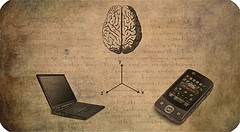 December 23, 2011 – „You will no longer need to create, track or remember multiple passwords for various log-ins” says IBM. „Imagine you will be able to walk up to an ATM machine to securely withdraw money by simply speaking your name or looking into a tiny sensor that can recognize the unique patterns in the retina of your eye. Or by doing the same, you can check your account balance on your mobile phone or tablet”.
December 23, 2011 – „You will no longer need to create, track or remember multiple passwords for various log-ins” says IBM. „Imagine you will be able to walk up to an ATM machine to securely withdraw money by simply speaking your name or looking into a tiny sensor that can recognize the unique patterns in the retina of your eye. Or by doing the same, you can check your account balance on your mobile phone or tablet”.
IBM has released its sixth-annual „IBM 5 in 5” list, a list of technology predictions that is fodder for both enthusiastic futurists and skeptics. The next „IBM 5 in 5” is based on market and societal trends as well as emerging technologies from IBM’s research labs around the world.
Here are how five technologies that IBM consider will define the future:
You will never need a password again.
 Your biological makeup is the key to your individual identity, and soon, it will become the key to safeguarding it. You will no longer need to create, track or remember multiple passwords for various log-ins. Imagine you will be able to walk up to an ATM machine to securely withdraw money by simply speaking your name or looking into a tiny sensor that can recognize the unique patterns in the retina of your eye. Or by doing the same, you can check your account balance on your mobile phone or tablet.
Your biological makeup is the key to your individual identity, and soon, it will become the key to safeguarding it. You will no longer need to create, track or remember multiple passwords for various log-ins. Imagine you will be able to walk up to an ATM machine to securely withdraw money by simply speaking your name or looking into a tiny sensor that can recognize the unique patterns in the retina of your eye. Or by doing the same, you can check your account balance on your mobile phone or tablet.
Each person has a unique biological identity and behind all that is data. Biometric data – facial definitions, retinal scans and voice files – will be composited through software to build your DNA unique online password.
Referred to as multi-factor biometrics, smarter systems will be able to use this information in real-time to make sure whenever someone is attempting to access your information, it matches your unique biometric profile and the attempt is authorized. To be trusted, such systems should enable you to opt in or out of whatever information you choose to provide.
Mind reading is no longer science fiction
 From Houdini to Skywalker to X-Men, mind reading has merely been „wishful thinking” for science fiction fans for decades, but their wish may soon come true. IBM scientists are among those researching how to link your brain to your devices, such as a computer or a smartphone. If you just need to think about calling someone, it happens. Or you can control the cursor on a computer screen just by thinking about where you want to move it.
From Houdini to Skywalker to X-Men, mind reading has merely been „wishful thinking” for science fiction fans for decades, but their wish may soon come true. IBM scientists are among those researching how to link your brain to your devices, such as a computer or a smartphone. If you just need to think about calling someone, it happens. Or you can control the cursor on a computer screen just by thinking about where you want to move it.
Scientists in the field of bioinformatics have designed headsets with advanced sensors to read electrical brain activity that can recognize facial expressions, excitement and concentration levels, and thoughts of a person without them physically taking any actions.
Within 5 years, we will begin to see early applications of this technology in the gaming and entertainment industry. Furthermore, doctors could use the technology to test brain patterns, possibly even assist in rehabilitation from strokes and to help in understanding brain disorders, such as autism.
The digital divide will cease to exist.
 In our global society, growth and wealth of economies are increasingly decided by the level of access to information. And in five years, the gap between information haves and have-nots will narrow considerably due to advances in mobile technology. There are 7 billion people inhabiting the world today. In five years there will be 5.6 billion mobile devices sold – which means 80% of the current global population would each have a mobile device.
In our global society, growth and wealth of economies are increasingly decided by the level of access to information. And in five years, the gap between information haves and have-nots will narrow considerably due to advances in mobile technology. There are 7 billion people inhabiting the world today. In five years there will be 5.6 billion mobile devices sold – which means 80% of the current global population would each have a mobile device.
As it becomes cheaper to own a mobile phone, people without a lot of spending power will be able to do much more than they can today. For example, in India, using speech technology and mobile devices, IBM enabled rural villagers who were illiterate to pass along information through recorded messages on their phones. With access to information that was not there before, villagers could check weather reports for help them decide when to fertilize crops, know when doctors were coming into town, and find the best prices for their crops or merchandise.
Growing communities will be able to use mobile technology to provide access to essential information and better serve people with new solutions and business models such as mobile commerce and remote healthcare.
Junk mail will become priority mail.
 Think about how often we’re flooded with advertisements we consider to be irrelevant or unwanted. It may not be that way for long. In five years, unsolicited advertisements may feel so personalized and relevant it may seem spam is dead. At the same time, spam filters will be so precise you’ll never be bothered by unwanted sales pitches again.
Think about how often we’re flooded with advertisements we consider to be irrelevant or unwanted. It may not be that way for long. In five years, unsolicited advertisements may feel so personalized and relevant it may seem spam is dead. At the same time, spam filters will be so precise you’ll never be bothered by unwanted sales pitches again.
Imagine if tickets to your favorite band are put on hold for you the moment they became available, and for the one night of the week that is free on your calendar. Through alerts direct to you, you’ll be able to purchase tickets instantly from your mobile device. Or imagine being notified that a snow storm is about to affect your travel plans and you might want to re-route your flight?
IBM is developing technology that uses real-time analytics to make sense and integrate data from across all the facets of your life such as your social networks and online preferences to present and recommend information that is only useful to you.
From news, to sports, to politics, you’ll trust the technology will know what you want, so you can decide what to do with it.
People power will come to life.
 Anything that moves or produces heat has the potential to create energy that can be captured. Walking. Jogging. Bicycling. The heat from your computer. Even the water flowing through your pipes. Advances in renewable energy technology will allow individuals to collect this kinetic energy, which now goes to waste, and use it to help power our homes, offices and cities.
Anything that moves or produces heat has the potential to create energy that can be captured. Walking. Jogging. Bicycling. The heat from your computer. Even the water flowing through your pipes. Advances in renewable energy technology will allow individuals to collect this kinetic energy, which now goes to waste, and use it to help power our homes, offices and cities.
Imagine attaching small devices to the spokes on your bicycle wheels that recharge batteries as you pedal along. You will have the satisfaction of not only getting to where you want to go, but at the same time powering some of the lights in your home.
Created energy comes in all shapes and forms and from anything around us. IBM scientists inIreland are looking at ways to understand and minimize the environmental impact of converting ocean wave energy into electricity.
***
The Next 5 in 5 initiative got its start in an IBM Innovation Jam in 2006. The seed goal was to get the entire company thinking about grand challenges. “If you give people a grand challenge you push them to really innovate,” says IBM Fellow Bernard Meyerson. “That’s when extraordinary things can happen.”
Meyerson, who plays a role in the annual exercise, says the most useful thing about the process is that it requires IBMers to think holistically about innovation. They can’t consider science and technology in a vacuum. They also have to think deeply about social trends, market conditions the willingness of people to pay for cutting-edge technologies. That’s the kind of thinking that can transform inventions into high-impact innovations.
See the full list of five in the video below:
http://www.youtube.com/watch?v=tuisda1q6ns&width=500&height=350
Banking 4.0 – „how was the experience for you”
„To be honest I think that Sinaia, your conference, is much better then Davos.”
Many more interesting quotes in the video below: